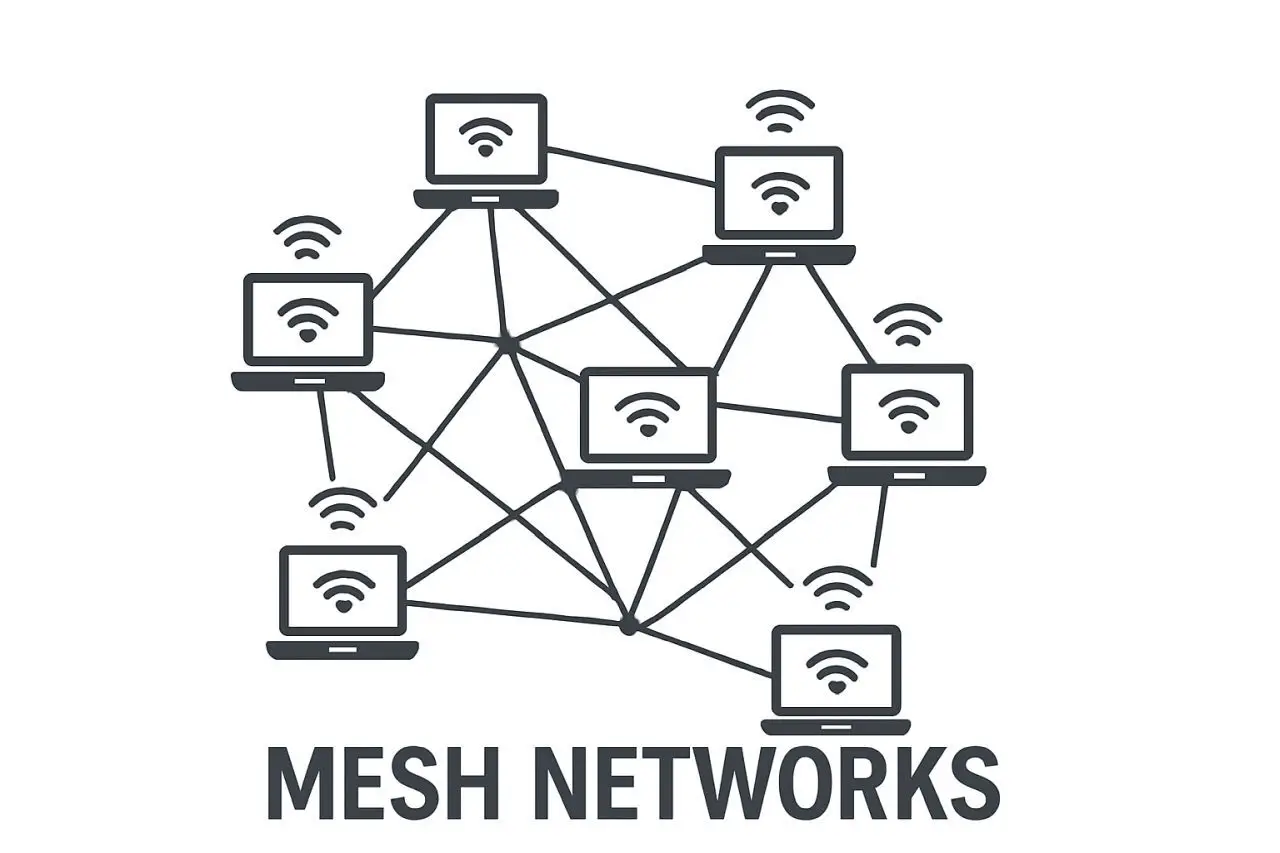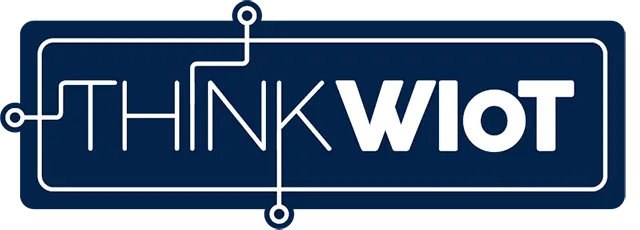Mesh Networks and Wireless Communication
Mesh networks are essential wireless communication architectures that provide resilient, scalable, and energy-efficient connectivity by leveraging decentralized routing and cross-layer protocol designs tailored to diverse applications.
- Published: June 25, 2025
- By: Anja Van Bocxlaer
- Read: 13 min
- Mesh networks provide decentralized communication with self-healing capabilities by dynamically routing data through multiple paths.
- Wireless mesh protocols operate on different OSI layers, from MAC-based routing (e.g., Zigbee) to managed flooding above the transport layer (e.g., Bluetooth Mesh).
- Popular mesh technologies include Zigbee, Thread, Wi-SUN, Bluetooth Mesh, Wi-Fi HaLow Mesh, and proprietary LoRa mesh extensions.
- Advantages of mesh networks include scalability, robustness, cost efficiency, and flexibility for dynamic environments.
- Challenges include higher power consumption, increased latency, complexity in management, and the necessity of strong security measures.
- Integration of Edge AI and energy harvesting facilitates intelligent, low-maintenance mesh nodes with autonomous operation.
- Hybrid network architectures combining mesh with LPWAN, 5G, and satellite communication enhance coverage and global data reach.

Basics of Wireless Communication
Where Does Wireless Communication Begin?
Wireless communication starts at the physical layer of the OSI model. Electrical signals—generated by a transmitter, such as a sensor or microcontroller—are converted into electromagnetic waves and transmitted through space via antennas. On the receiving end, a radio module captures the waves and converts them back into electrical signals.
This process occurs on the circuit board of a device—for example, in a battery-powered LoRa sensor or a BLE-enabled light switch. The physical layer is directly connected to the transceiver, which defines the frequency band, modulation, and output power.
Different technologies use different frequency bands and modulation methods:
BLE (Bluetooth Low Energy) operates at 2.4 GHz using GFSK modulation. It's optimized for short-range, energy-efficient communication.
Wi-Fi HaLow (IEEE 802.11ah) operates in sub-GHz bands (e.g., 868 MHz) and offers long range with low power consumption.
LoRa uses Chirp Spread Spectrum in the 433/868/915 MHz bands and is known for extreme range and energy efficiency.
The OSI Model as a Technical Framework
A central concept in networking is the protocol—a standardized agreement on how devices exchange data: what formats, sequences, and responses are expected. Protocols exist at every OSI layer and define behavior per layer.
The OSI model divides communication into seven layers—from physical signal to application logic. Each layer has a specific function:
Layer 1 – Physical Layer: Transmission of bits via signals (radio/optical). Includes modulation, frequency selection, antennas.
Layer 2 – Data Link Layer: Manages MAC addresses, channel access, error checking. Enables direct communication between two nodes.
Layer 3 – Network Layer: Responsible for routing across networks. Uses IP addresses and routing protocols.
Layer 4 – Transport Layer: Ensures end-to-end delivery, e.g., TCP/UDP. Often simplified in mesh systems.
Layer 5–7 – Session, Presentation, Application: Often combined in mesh systems. Layer 7 includes CoAP, MQTT, HTTP.
Especially in low-power embedded systems, the OSI model is interpreted pragmatically—layers may be merged or simplified.
Protocol Stack: From Physical Layer to Application
A protocol stack defines which protocols are used at each layer. A typical LoRa stack might include: LoRa PHY (L1), LoRa MAC (L2), simple mesh routing (L3), and CoAP (L7). Mesh protocols often use cross-layer designs, blurring strict layer separation.
What is a Mesh Network?
Structure and Functionality
A mesh network is a decentralized system in which each node can both send data and forward it. Routes are determined dynamically. If a path fails, the network finds alternatives—creating self-healing and robust structures.
Contrast with Classic Topologies
Unlike star or tree topologies, mesh networks don't rely on central nodes. Multiple paths allow load balancing and fault tolerance—ideal for wide or dynamic environments.
Requirements for Mesh Functionality
A functioning mesh needs:
Routing protocols
Neighbor discovery
Forwarding logic
Resilience mechanisms (e.g., TTL, caching)
Security (authentication & encryption)
TTL (Time to Live): A counter in each packet decreases with every hop. When it reaches zero, the packet is dropped—preventing infinite loops and reducing network load.
Mesh Technologies in Detail
On Which Layer Does Mesh Occur?
Mesh communication can take place on different OSI layers, depending on the technology:
Layer 2 (MAC): Zigbee, Thread, and Wi-Fi Mesh use routing directly on the data link layer. This means that packets are forwarded based on MAC addresses or internal node IDs, without relying on IP addresses.
Layer 3 (Network): IP-based mesh systems such as Thread (in IPv6 mode) or specific LPWAN protocols use traditional routing mechanisms based on IP addresses.
Above Layer 4: Bluetooth Mesh implements its mesh behavior above the transport layer. It uses what is known as managed flooding, where data packets are distributed across many nodes without relying on traditional routing tables.
In conventional IP networks, routing typically takes place only on Layer 3 (the network layer). However, mesh protocols like Zigbee, Thread, or Wi-Fi Mesh implement routing directly on Layer 2. In these cases, packet forwarding is done using MAC addresses or internal network identifiers rather than IP addresses. This reduces resource consumption and allows for more compact and tailored protocols.
Overview by Layer:
Layer 2 (MAC): Zigbee, Thread, Wi-Fi Mesh
Layer 3 (Network): IPv6-based mesh systems
Above Layer 4: Bluetooth Mesh uses managed flooding between transport and application layers
Cross-Layer Communication and OSI "Softening"
Many protocols combine functions across multiple layers—a strategy that is especially useful for devices with limited energy and memory resources. In doing so, the classic separation between OSI layers is intentionally relaxed:
Cross-layer designs allow, for example, information from Layer 1 (such as received signal strength) to influence routing decisions at Layer 3.
Zigbee and Thread use routing on Layer 2, entirely bypassing the IP layer to make transmissions more efficient.
Bluetooth Mesh uses its own message format and routing method, functionally positioned between Layer 4 and Layer 7—without IP, but with TTL, retransmission, caching, and broadcasting mechanisms.
The goal of such designs is to save energy, minimize latency, and replace complex network infrastructure with specialized, streamlined protocols. The OSI model still serves as a conceptual reference—but it is applied pragmatically.
In summary, many protocols combine functions across several layers. This enables energy-efficient behavior and lower latency. Mesh routing on Layer 2—bypassing the IP layer—is often more effective in wireless networks.
Why There Is No One-Size-Fits-All Mesh Technology
Each wireless technology comes with its own physical characteristics—such as frequency, packet size, bandwidth, and energy profile. This makes specialized mesh protocols necessary. In addition, economic factors like manufacturer ecosystems and standardization efforts play a role, as do the diverse application scenarios—ranging from smart cities to sensors deployed deep in forests.
Hardware and Software Requirements
Radio Modules and Chipsets
The radio module must not only support the required frequency band but also offer mesh capabilities. Popular SoCs include the Nordic nRF52 series (for BLE Mesh), Silicon Labs EFR32 (for Zigbee/Thread), and the Semtech SX126x (for LoRa Mesh).
Power Supply and Energy Harvesting
Many mesh nodes are battery-powered. However, energy harvesting concepts—such as solar cells or piezoelectric converters—are becoming increasingly important to enable low-maintenance networks.
Mesh Stacks and Firmware
In addition to hardware, a mesh protocol stack is required. It must handle routing decisions, perform neighbor discovery, manage timeouts, and implement security features such as encryption.
Overview of Wireless Mesh Technologies
Wireless mesh technologies differ in terms of frequency, topology, addressing, and energy management. Some technologies—such as Zigbee and Thread—are inherently designed for mesh networking and function exclusively in a meshed structure. Others, like Bluetooth or LoRa, require specific extensions or configurations to support mesh functionality.
Zigbee
Zigbee is a mature mesh standard for wireless sensor networks, primarily used in smart home and building automation. It operates in the 2.4 GHz band (optionally 868/915 MHz) and is based on IEEE 802.15.4. Zigbee always runs in mesh mode: each network consists of a coordinator, routers, and end devices. Routers forward data, allowing the network to self-organize and establish new paths in the event of node failures. Interoperability across manufacturers is a key feature of Zigbee.
Thread
Thread was developed for reliable and secure IP communication in smart homes. It is also based on IEEE 802.15.4 (2.4 GHz) and always operates in mesh mode. Thread is fully IPv6-capable and supports native integration into IP networks. It enables encrypted communication, automatic self-healing, power-saving features, and forms the networking foundation of the Matter smart home standard.
Wi-SUN
Wi-SUN (Wireless Smart Utility Network) is a standardized, IP-based mesh communication system based on IEEE 802.15.4g. It was developed for large-scale, reliable, and energy-efficient networks in urban and industrial infrastructure. Mesh routing is a core part of the protocol stack, implemented using the RPL routing protocol at Layer 3.
While all Wi-SUN devices are mesh-capable by design, only selected nodes perform active routing functions. This results in a highly scalable, self-organizing network that provides long-range and robust data transmission even in harsh environments.
Bluetooth Mesh
Bluetooth Mesh is an extension of the Bluetooth Low Energy (BLE) standard and enables meshed communication through “managed flooding.” In this approach, a device sends a message that is forwarded by nearby nodes. Mesh functionality is not part of BLE itself and must be explicitly implemented. Bluetooth Mesh is particularly suited for time-critical applications requiring redundancy—such as lighting control or access management.
Wi-Fi HaLow Mesh
Wi-Fi HaLow (IEEE 802.11ah) was developed for long-range, energy-efficient IoT applications. The first commercial implementations with mesh functionality are expected in 2025, enabling large-scale coverage in environments such as warehouses, industrial facilities, or agriculture. Unlike Zigbee or Thread, mesh in Wi-Fi HaLow is optional and depends on the stack used.
LoRa Mesh
LoRaWAN was originally designed as a star topology with a central gateway. However, proprietary mesh extensions from vendors and open-source projects now exist. These are used in remote areas without gateway infrastructure—such as agricultural systems or environmental monitoring. In such setups, certain nodes act as routers, while others serve as simple end devices.
Strengths and Weaknesses of Mesh Networks
Advantages
Mesh networks offer numerous technical and operational benefits:
Self-Healing: If a node fails, an alternative route is automatically found without human intervention.
Scalability: New devices can be easily added; the network dynamically reconfigures itself.
Cost Efficiency: Fewer gateways or centralized infrastructure are needed, reducing installation and maintenance costs.
Robustness: Mesh networks adapt flexibly to changes in the radio environment or physical obstructions.
This makes mesh topologies especially suitable for applications with dynamic conditions and large coverage areas—such as agriculture, industrial facilities, or urban infrastructure.
Challenges
Despite their advantages, mesh networks also come with certain challenges:
Power Consumption: Each device must also act as a repeater, increasing energy requirements compared to classic end devices.
Increased Latency: Each hop introduces additional delay, which must be considered in time-critical applications.
Complexity: Configuration, troubleshooting, and optimization of a mesh network require experience and the right tools.
Security: Since data passes through multiple nodes, strong encryption and authentication are essential to prevent attacks.
Successful deployment requires careful planning, appropriate protocols, and effective monitoring tools.
Real-World Applications of Mesh Technologies
Smart Agriculture
In agriculture, LoRa mesh systems enable wide-area networking of sensors for soil moisture and weather monitoring. Thanks to LoRa’s long-range radio technology and the ability to relay messages node-to-node without a gateway, even vast agricultural fields can be reliably covered.
Solar-powered nodes significantly reduce maintenance needs. LoRa Mesh is particularly suitable for regions with limited infrastructure—such as rural areas in Africa, South America, or parts of Europe.
Building Automation
BLE Mesh networks offer clear advantages for connecting lights, sensors, and actuators in modern office buildings, hotels, and industrial facilities. The decentralized architecture allows for easy retrofitting without costly wiring.
When combined with occupancy and light sensors, energy-efficient lighting control can be implemented. Bluetooth Mesh delivers low latency, minimal power consumption, and reliable redundancy via flooding mechanisms.
Smart Cities
In urban infrastructure, Zigbee and Thread mesh networks are commonly used—for example, for monitoring air quality, traffic flow, or waste bin levels. Their high node density and self-healing capabilities make Zigbee ideal for environments with fluctuating network loads and physical obstructions.
Thread stands out for its IPv6 compatibility and is a strong fit for open, IP-based platforms. Both technologies are energy-efficient and well-suited for large-scale, heterogeneous networks with high interoperability.
Industrial Manufacturing
Wi-Fi HaLow Mesh is used in manufacturing environments where long range, low latency, and high device density are required. Typical use cases include wireless real-time machine data transmission, integration of mobile robots, or condition monitoring of assets.
Thanks to robust sub-GHz signal characteristics, Wi-Fi HaLow Mesh is less prone to interference in metallic environments—a key advantage over traditional 2.4 GHz solutions.
Articles on Think WIoT
BLE-Based Mesh Networks Protect 7,000 Mayo Clinic Employees
The Mayo Clinic in Rochester, Minnesota, has implemented a mobile emergency solution for 7,000 employees, based on a real-time location system (RTLS) using Bluetooth Low Energy (BLE), BluFi gateways, and a mesh network.
At the core of the system is a discreetly worn employee badge with an integrated emergency button and BLE beacon. When activated, the signal is received by BluFi BLE antennas, which communicate via a mesh network and forward the data to a central cloud platform (Bluzone). There, precise location tracking is performed based on signal strength from various mesh nodes.
The mesh network architecture enables redundant, energy-efficient, and wide-area communication—even in complex building environments. Through the cloud-based platform, all devices can be centrally managed, policies defined, and emergencies located in real time. The combination of RTLS, BLE, and mesh networking thus provides a scalable, fail-safe security solution to combat workplace violence in the healthcare sector.

Intelligent Nodes through Edge AI
The integration of Edge AI (artificial intelligence directly on the device) is fundamentally transforming mesh networks. Sensors and actuators can analyze data locally, detect patterns, and make decisions before any communication with other nodes or a central platform takes place. This saves bandwidth, reduces latency, and increases network autonomy.
In practice, this means: A temperature sensor equipped with AI can detect critical changes early and trigger a local response—without routing data through the cloud. Especially in time-sensitive or poorly connected environments, Edge AI becomes a key enabler of intelligent mesh networks.
Autonomous Networks through Energy Harvesting
Energy harvesting—the collection of energy from the environment (e.g., solar, vibration, temperature gradients, or radio waves)—makes mesh nodes maintenance-free. This is a major advantage in hard-to-reach areas such as industrial facilities, forests, or infrastructure corridors.
Self-powered sensors can remain active in the network indefinitely, without battery replacement or external power supply. When combined with low-power radio standards like LoRa or BLE, a new paradigm emerges: energy-autonomous, self-organizing networks that operate maintenance-free for years.
Hybrid Architectures with LPWAN, 5G, Satellite
Mesh networks do not need to function in isolation. By combining them with LPWAN (e.g., LoRaWAN), 5G, or satellite communication, hybrid infrastructures are created that link local intelligence with global reach. For example, mesh can be used to distribute data within a factory, while selected nodes transmit aggregated information via 5G or LoRaWAN.
In agriculture or logistics, mobile nodes can establish mesh communication locally and, when needed, relay information via satellite to central systems. These hybrid architectures are particularly robust and scalable—even in harsh environments or areas with poor network coverage.
Mesh as a Component of Digital Twins
Digital twins—virtual representations of physical systems—require a constant stream of current data. Mesh networks provide a reliable foundation for this. They enable continuous collection and forwarding of sensor data from machines, buildings, or infrastructure directly to the digital twin. Digital twins benefit from the high granularity and near real-time nature of this data.
Conversely, the twins can also trigger actions in the physical network—such as responding to anomalies or initiating predictive maintenance. Mesh becomes the link between the physical world and digital intelligence, playing a key role in Industry 4.0.
